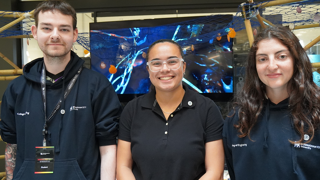Our BCU students collaborated with Cal Poly to create an immersive travelling exhibit educating the public on the decommissioning of oil rigs off the coast of Santa Barbara.
How did the collaboration with Cal Poly and BCU get started?
The collaboration between Cal Poly and BCU was initiated through the efforts of Dr. David Gelatt, an instructor at Cal Poly, who has a close relationship with several people at BCU. This connection gradually evolved into a significant project, integrating students from various disciplines such as liberal arts and engineering at Cal Poly and architecture, business, and engineering at BCU.
What is the aim of the project?
The primary aim of the project is to create a travelling exhibit designed to educate the public about the decommissioning of oil rigs off the coast of Santa Barbara, California. This exhibit will feature an immersive VR experience to inform people about the ongoing activities and issues related to these oil rigs, an area many are unaware of. The current phase of the project focuses on developing the entryway to this immersive experience.
How are BCU and Cal Poly working collaboratively?
BCU and Cal Poly have been collaborating since January 2024, utilising Microsoft Teams to facilitate communication across different time zones. The collaboration involves overcoming cultural differences and integrating various disciplines, allowing students to engage in tasks outside their usual scope. This interdisciplinary approach has enabled architecture students to engage in writing and engineering students to participate in creative processes.
Engineering Courses
Find out more about our courses
What is the expected outcome?
The expected outcome is to develop a travelling exhibit that can be showcased throughout California, providing education on the decommissioning of oil rigs off the coast of Santa Barbara. For the present, the project aims to create a prototype of the entryway to this immersive VR experience, setting the stage for the full exhibit.
What role do our engineering students play in the project?
Engineering students have played a critical role in the project, primarily responsible for the design and construction aspects. They have worked on designing and iterating the brackets, ensuring structural stability and sustainability. Their contributions have been pivotal in bringing the project from concept to reality, with significant input from all team members.
What skills have the students learned that will benefit them the most in the future?
Students have gained valuable skills in teamwork and collaboration, especially in working with peers from different cultural and educational backgrounds. They have learned to manage time zones, scheduling differences, and cultural norms. Additionally, technical skills such as 3D printing, communication, and poster creation were developed. However, the most significant learning was how to effectively collaborate across borders and cultures.
What did the students value most in this project?
Students particularly valued the opportunity to exercise creativity and work on a project that went beyond typical classroom assignments. They appreciated the interdisciplinary nature of the project, which allowed them to consider aspects like sustainability and communication. Moreover, the social aspect of building friendships and forming a cohesive team was highly valued, enhancing their overall experience and making the project rewarding on both professional and personal levels.
Working with Cal Poly has been a great success! We look forward to seeing their project come to life and to continue to forge strong international partnerships that ignite innovation for a sustainable future.
